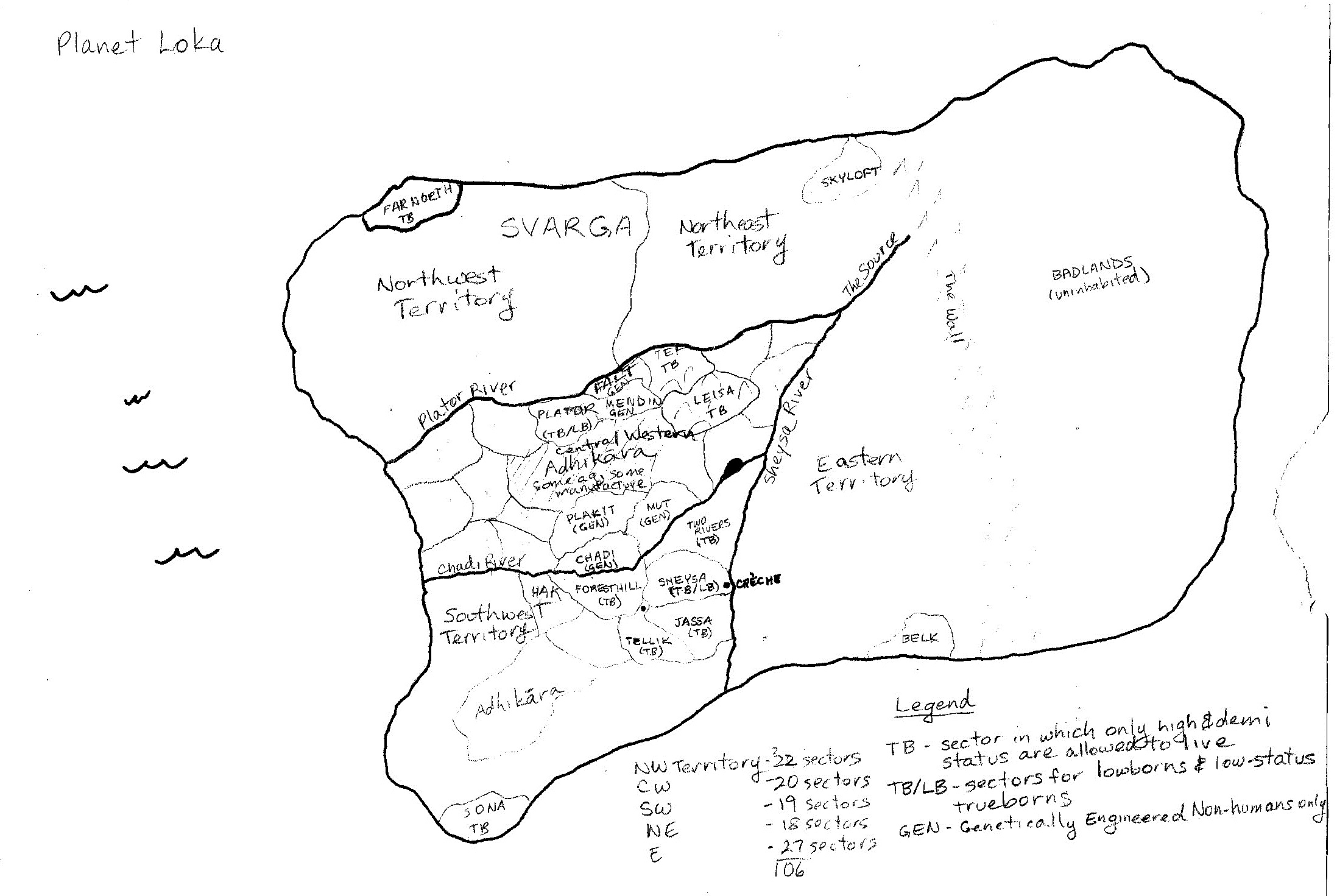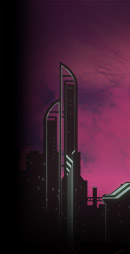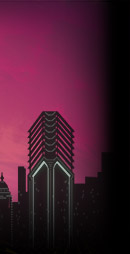Tankborn Working Papers
As I worked on Tankborn, I would find I needed certain tools to keep track of the story and the world I was creating. For instance, I needed a map of Svarga, the one inhabited continent on the planet Loka where Tankborn takes place. I also wanted a calendar to keep track of time transitions in the story. During the rewrite process, I also needed notes on Loka's government, social structure, flora and fauna, and history.
Map of Loka

Map above is a crudely drawn version of the map that appears in the book. I named and added sectors as they were mentioned in the story.
Top | Loka Map | Lokan Calendar | Lokan Castes | Lokan Government | Lokan Flora and Fauna
Lokan Calendar
|
The Lokan calendar consists of ten months:
Ardtus (33 days)
Andara (33 days)
Triu (33 days)
Anceachtu (33 days)
Cuigui (33 days)
Seu (33 days)
Anseachtu (33 days)
Ochtu (33 days)
Saou (33 days)
Deichiu (33 days)
|
There are six days of the week:
Restday
Firstday
Secday
Thirday
Forday
Fifday
|
The start dates for the seasons are as follows:
Spring - Trui 1st
Summer - Cuigui 15th
Autumn - Ochtu 1st
Winter - Deichui 16th
|
Top | Loka Map | Lokan Calendar | Lokan Castes | Lokan Government | Lokan Flora and Fauna
Lokan Castes
|
| Class/Subclass | Definition | Characters |
| Trueborn | Trueborns are all awarded "land grants"(adhikar) upon birth |
High-Status
diamond bali |
A direct descendant of one of the "first families." The first families were "Brahmin" caste and with their tremendous wealth contributed the bulk of the money needed to design and construct the colony ships. All in the high-status class are of Indian descent. If a high-status trueborn falls into economic hardship, it can knock them down to demi or minor-status (although not to lowborn). They can also lose status by marrying into a demi-status family (or, even worse, a minor-status family). |
Zul
Devak
Ved |
Demi-Status
emerald bali |
A direct descendant of one of the "middle families" who provided secondary funding, mostly for supplies and equipment outside the colony ships. Like the high-status, a demi family that loses its wealth or marries into a minor-status family would lose status, i.e. a demi would become minor-status. |
Livot
Pia |
Minor-Status
sapphire bali |
A direct descendant of one of the "minor families" (a highly educated upper middle class) who contributed what wealth they had and also their brain power. They were engineers and technicians on Earth. |
Luka
Ansgar |
| Lowborn | Lowborns are not permitted to own lands or businesses |
|
Descendants of the families without any wealth to contribute to the emigration project. They instead performed the more menial tasks involved in preparing to leave Earth. These families agreed to indentured servitude on Loka for ten generations in exchange for their passage to the new world. Their freedom was deferred for decades more by trueborns using excuses such as needing to strengthen societal stability and because of the Geming Plague and other crises. The lowborns mounted several unsuccessful insurrections, but weren't released from servitude until the GENs were established. |
Eoghan
Ilian |
| GEN | Genetically Engineered Non-humans |
|
GENs are genetically engineered for certain functions. At first, GENs were started using embryos from all classes that were brought from Earth. Eventually the original frozen embryos degraded to the point that they could no longer be used and techniques were developed to create stem cells from other body cells and use those stem cells for "artificial" embryos. The purpose of the GENs was to relieve the pressure from lowborn unrest, to finally follow through on the promise of release from indentured servitude. |
Kayla
Mishalla |
Top | Loka Map | Lokan Calendar | Lokan Castes | Lokan Government | Lokan Flora and Fauna
Lokan Government Structure
- A parliamentary government
- 160 members
- 120 are high-status trueborns
- 32 are demi-status trueborns
- 8 are minor-status trueborns
- Seats are determined partly by population, but also by tradition
- Main purpose of the Congress is to further prosperity for trueborns
- 106 sectors (not counting land grant sectors)
- 53 are limited to high- and demi-status trueborns
- Small groups of lowborns live on the outskirts (all but on top of the border) of most trueborn-only sectors
- 28 minor-status trueborn/lowborn sectors
- Lowborns live more densely than trueborns
- 25 GEN only sectors
- much higher population density
- evenly dispersed (/sector)
- Lowborn representation is via the trueborn-only CLW (Committee for Lowborn Welfare)
- Citizenship is restricted to those who own property or businesses. Those who work for others are not citizens (unless they own property). All trueborns receive an adhikar grant (land grant) when they're born. There are sectors within each sector with the sole purpose of providing land ownership, and therefore citizenship rights, to trueborns. Lowborns are not allowed to own land or their own businesses. If they want to run a business, they must find a trueborn to "sponsor" them (be the recognized owner), to whom the lowborn must pay a fee (although that trueborn has no other involvement in the business).
- GENs have no representation in Parliament
- Humane Treatment Edicts were passed by Parliament 20 years ago, but are widely ignored
- Theoretically, the Judicial Council is supposed to oversee GEN welfare issues, but rarely intervene unless someone's property (i.e., GEN) is in danger of being damaged by someone else.
- The Judicial Councils oversee GEN issues, the Brigade, criminal and civil proceedings and land grant issues
- Supreme Judicial Council is final word
- Sub-Councils for each Territory
- GEN issues include laws relating to how GENs are dispersed, ownership issues, some re-alignment issues.
- Svarga continent is divided into territories
- Five territories
- Northwest (~400 million acres)
- Central Western (~400 million acres)
- Southwest (~400 million acres)
- Northeast (~400 million acres)
- Eastern (~500 million acres)
- Within each territory, 20% of the acreage (100 million in Eastern Territory, ~90 million in each of the other four) is set aside for adhikar grants
- Originally, what was available to be granted was useful, arable land, but as time has gone on, the parcels remaining are mostly arid and unusable.
- Land grants are apportioned according to trueborn status:
- High-status receive 200 acres
- Demi-status receive 100 acres
- Minor-status receive 10 acres
- Only about 20% of the adhikar acreage remains. What to do about future generations of trueborns is a much-discussed issue. Possible solutions include lowering the apportionment for each trueborn or allowing an escrow (money contributed by the parents) in lieu of land ownership or the child's family subdividing their adhikar.
- Some members of the Brigade are minor-status trueborns who had to sell their grants due to financial hardship. Their position in the Brigade and some other governmental positions maintains their citizenship. It's a professional version of indentured servitude. Guntram and Ansgar are both working to buy back into the "landed gentry."
Top | Loka Map | Lokan Calendar | Lokan Castes | Lokan Government | Lokan Flora and Fauna
Flora
Plants include grasses on the plains (including the ubiquitous scrap grass) which were genetically engineered by trueborn gene-splicers to create the kel-grain that sustains much of the lowborn and GEN population. There's also sage-like brush (sticker bushes), thistle-type plants (chaff heads with blue flowers), yellow scrub flowers. Wheat didn't survive on Loka, rice did (although it's so water-intensive, it's only for the rich). Kel-grain can be used to make naan, but it's not quite the same.
There are also junk trees, leafless trees that use a symbiotic relationship with a fungus (and the jot spider) to survive.
Fauna
Animal life on Loka is mainly arachnid-based. Sewer toads are actually a type of non-venomous water spider. Rat-snakes are neither rats nor snakes, but an 8-legged creature with a long, flexible thorax and a rat-like head. A number of Lokans were lost to the various arachnid venoms before the population could be inoculated.
There are a few mammals which for the most part are naturally immune to predator venoms. Weaker or sick mammals will succumb to an arachnid attack. One of the smallest mammals is a feline called a seycat which stands about 15 inches at the shoulder. They make good "ratters," able to catch and eat the rat-snakes and other small arachnids. Seycats will quickly bite off the heads of their arachnid prey to avoid being bitten.
There's also a native bovine-type mammal that's about pony-sized. They were genetically engineered to be closer to camel-sized (since the Earth cows didn't survive), both to provide a greater quantity of meat and milk and to resist the predation of the mother of all arachnids, the bhimkay. Imagine a Great Dane-sized tarantula and you'll have a sense of the size of the bhimkay.
Top | Loka Map | Lokan Calendar | Lokan Castes | Lokan Government | Lokan Flora and Fauna
|
|





